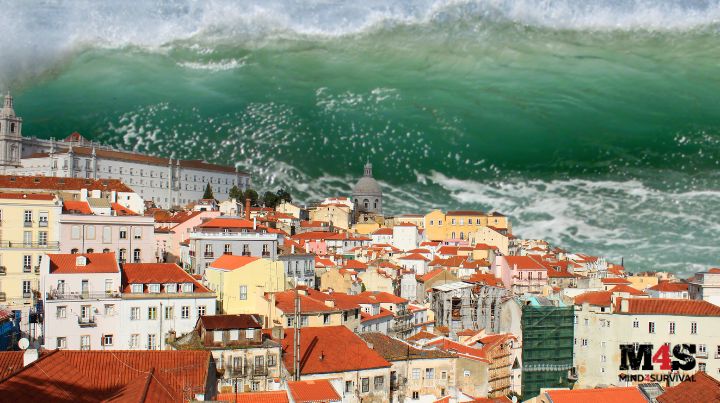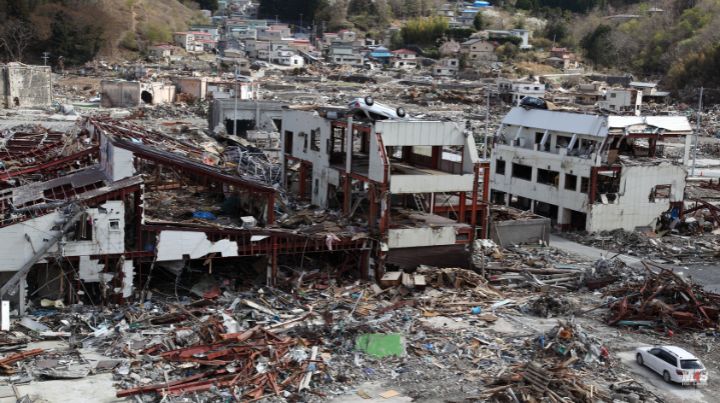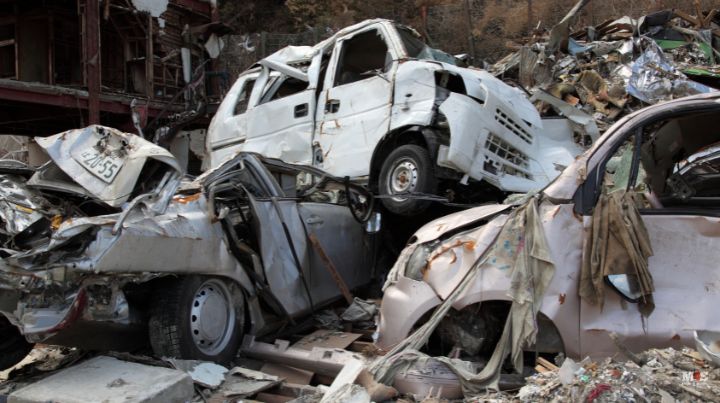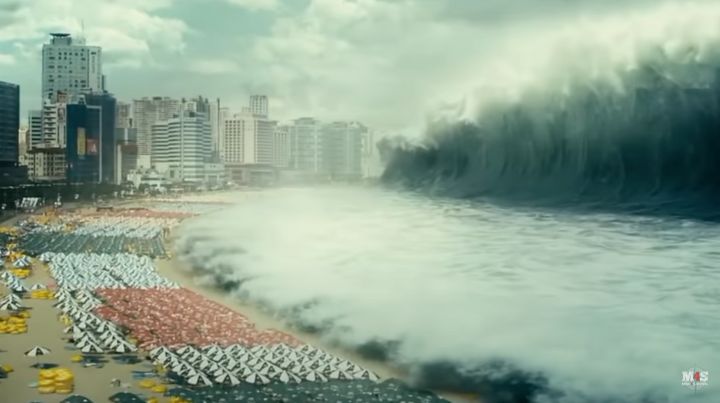How to Survive a Tsunami | Guide & Tips (2023)

The threat of tsunamis is real. As the 2004 Indian Ocean tsunami, also known as the Boxing Day Tsunami, shows, if you live near or plan on visiting the beach, you should be prepared to act in the event of a tsunami. When facing a tsunami, or any disaster, the first step is to arm yourself with the knowledge necessary to help you survive the event. With that, here are some preparedness tips to help you survive should your next stay at the beach be smashed by a tsunami.
What is a Tsunami
A tsunami, also known as a seismic sea wave, is a large and powerful ocean wave caused by sudden movements of the Earth's crust. These movements can be from earthquakes, volcanic eruptions, landslides, or even meteorite impacts. Tsunamis are not like ordinary wind-generated waves that occur in the ocean daily; instead, they form a very long wall of water that travels across the ocean at high speeds.
Tsunami vs. Tidal Wave
While many people use the terms tsunami and tidal ave interchangeably, they are vastly different and should not be confused with one another. On that topic, the U.S. Geological Survey states:
Although both are sea waves, a tsunami, and a tidal wave are two different and unrelated phenomena. A tidal wave is a shallow water wave caused by the gravitational interactions between the Sun, Moon, and Earth “tidal wave” was used in earlier times to describe what we now call a tsunami.) A tsunami is an ocean wave triggered by a massive earthquake that occurs near or under the ocean, volcanic eruptions, submarine landslides, or onshore landslides in which large volumes of debris fall into the water.
How Big Can a Tsunami Get
When a tsunami forms close to shore, it becomes much higher than the regular waves on the surface of the ocean due to an effect called shoaling. This process occurs when the energy from the tsunami is focused into a smaller area as it approaches shallow waters near shorelines. The height of a tsunami's enormous ocean waves can range anywhere from 10 feet (3 m) to 100 feet (30 m).
The Destructive Force of Tsunamis
Tsunamis are incredibly destructive and dangerous due to their immense size and power. They first arrive as a series of cresting waves that increase in size and intensity before reaching land. When they reach land masses, these waves can cause catastrophic flooding and damage structures along coastlines with incredible force. In addition to their destructive power, tsunamis can contaminate water sources, and due to their strong currents, they can quickly transport deadly debris for miles.

Official Tsunami Warning Efforts
To protect citizens from tsunamis, governments have implemented early official tsunami warning systems which send out alerts for people living on or near coastlines so they can evacuate before disaster strikes. Additionally, many organizations are devoted to educating people about what steps to take before, during, and after a potential tsunami threat hits their area.
By being aware of how tsunamis form, understanding the warning signs of one coming, and knowing what safety measures you should take if you encounter one, you can help yourself remain safe during these devastating events.
Preparing for a Tsunami
While tsunamis cannot be prevented, preparing for them and minimizing their impact on you and your family is possible. Some tips for preparing to survive a tsunami include:
- Knowing the warning signs, both man-made and natural.
- Pre-plan evacuation routes and safe havens.
- Prepare a tsunami survival kit.
- Create a family emergency communication plan.
- Practicing tsunami drills with your family and community.
Tsunami Warning Signs
Because tsunamis often begin hundreds of miles or more away from the beaches they crash into, coastal residents and visitors must be aware of the warning signs of tsunamis.
Man-Made Tsunami Warning Signs
When it comes to predicting tsunamis with scientific instruments, seismometers are used to measure seismic activity along fault lines and locate earthquakes that might trigger them. In deep waters where earthquakes occur more frequently on the ocean floor, buoys and deep-ocean pressure gauges can measure changes in pressure and alert coastal areas if a rapid increase is detected.

In addition to the tsunami detection systems deployed in the open oceans, many local emergency managers have taken steps to warn the citizens of danger. Because of this, it's a good idea to know what warnings the local authorities may issue should a tsunami happen.
In the end, though, local authorities and open ocean warnings are not 100% reliable. Therefore, knowing the tsunami warning indicators Mother Nature provides is important.
Natures Tsunami Warning Signs
Some of the warning signs of a tsunami include:
- an abrupt rise or fall in coastal water levels
- large and unusually strong ocean currents
- loud noises coming from the shoreline
- strong and unusual wave patterns
- even an earthquake or other seismic activity.
It is important to note that these warning signs can also indicate other forms of coastal flooding or erosion.
In addition to these physical warning signs, some environmental indicators may indicate an impending tsunami. For example, seabirds have been known to fly inland when they sense a tsunami coming their way. Similarly, marine life often reacts differently just before the arrival of tsunami waves by either swimming away from shore or quickly descending into deeper waters.
Tidal Bores and Wave Patterns
Furthermore, a preceding wave pattern may be observed in rare circumstances before a tsunami reaches land. Called ‘tsunami bores,' this surge in water can cause dangerous rip currents and fast-moving waves, which may serve as warnings for those near the shore. A booming sound can also sometimes be heard before the full force of the wave arrives.
Pre-planning Evacuation Routes Away From the Coast

In a tsunami, there is little time to make decisions and react. Developing escape routes in an area prone to tsunamis will be vital in guaranteeing one's safety and protecting lives should a tsunami happen. With some research and effort, it is possible to map out potential evacuation options that will serve as a guide in an emergency.
Consider some of the following when creating your PACE plan for surviving a tsunami:
Speed (Primary)
Moving as far away from the beach as quickly as possible is critical to tsunami evacuation route planning. When planning for a speedy route, look for avenues of egress that avoid highly trafficked and congested areas. These routes will quickly become bogged down with others trying to flee the tsunami hazard zone.
As you plan your routes, consider how fast you can move ahead of the approaching tsunami. That way, you'll have a better idea if you can make it inland far enough to avoid the flood waters or if you'll have to move on to another phase of your contingency plan.
For example, if you know it will take 30 minutes to get far enough inland to avoid the effects of the tsunami and have an hour, then you can focus on getting as far away from the beach as possible. However, if your first sign that a tsunami may be coming is the receding waterline, then you know a tsunami is imminent, and you can move to another phase of your PACE plan.
High Ground (Alternate):
When planning for a speedy evacuation route away from the coast in case of a tsunami, choosing primary and alternate routes that move you inland and lead you to higher elevations as quickly as possible is essential.
For this reason, it is helpful to take some time before an emergency arises to research and map out potential evacuation routes away from the coast. There are numerous elements to consider when planning a course of action in a tsunami-prone area. Speed is essential as getting as far away from the beach quickly is the primary key to survival. For this
Tall Buildings (Contingency):
If you cannot reach higher ground quickly, consider adding a contingency plan to utilize tall buildings along your route as safe havens. These buildings can act as a life raft above the rushing water should no other options be available. When choosing buildings as a safe haven, try to locate buildings as far inland as possible. Also, select buildings that are structurally sound and, when possible, not in the direct path of the raging water.
Worst Case (Emergency):

If you cannot escape the tsunami hazard zone, do your best to avoid a direct impact. Look for side streets and alleyways that will help you to avoid a direct frontal impact by the force of the rushing water. This is important because as the tsunami pushes inland, it will pick up debris, such as cars, buses, houses, etc., that will batter and kill anyone in its path.
Finding protective avenues away from the main force of the turbulent debris-filled water will help increase your chances of survival. Also, look for options to help keep you above the water, such as grabbing onto a pole or debris that will help you float on the surface.
Excellent Tsunami Survival Movie: The Impossible
In addition to watching for dangerous debris, be sure to watch for and avoid downed power lines. Downed power lines can electrify the water around the power lines, which means you do not have to touch the power lines to be incapacitated to killed by the electricity.
Don't Procrastinate!
The best time to devise an escape plan is before a tsunami arrives. Knowing exactly where to go and how to get there can save precious moments when reacting quickly means the difference between life and death. In that vein, if you see any warning signs that a tsunami may be imminent, don't let your normalcy bias slow you down by questioning and doubting yourself, get going and evacuate immediately.
If a tsunami doesn't materialize, you've added to your preparedness by acting quickly and rehearsing your response. Then, once you're sure the coast is clear (pun intended), you can return to enjoying the beach. In the end, delaying a response to a massive wall of incompressible water heading your way is a recipe for your demise.
Prepare a Tsunami Survival Kit

A tsunami emergency kit is always a good idea if you live in an area with a tsunami risk. That's because you may find yourself trapped and on your own for several days or longer after surviving the initial wave and flooding. Therefore, having an emergency kit ready to go will help you turn a deadly situation into a survivable situation.
First Aid Kit
With the amount of debris and chaos generated by a tsunami, it's highly likely that people, including yourself, will be cut, battered, and bruised while surviving the event. Therefore, you should have a plan and the resources necessary to treat various injuries, including lacerations, broken bones, and other traumas, from being tossed around in Mother Nature's rinse cycle.
Water Gathering, Purification, and Storage
Clean drinking water may be in short supply following a tsunami. That's because salt water can contaminate freshwater sources, along with making any local water purification and delivery system inoperable. Because of that, you will want a way to gather, purify, and store fresh water.
With that, consider adding a single-walled, stainless-less steel water bottle and a water filter such as a Sawyer Mini. This will give you the ability to not only gather water but also filter, boil, store, and transport it if needed.
Nourishment
As discussed previously, you may find yourself on your own for several days or longer following a tsunami. Therefore, you should consider adding some items, such as food bars or other calorie-dense options, to your survival kit. Food items such as protein bars and meal replacement bars that do not require cooking and can be kept in a water-tight bag, such as a Ziploc baggie, can be ideal.
Create a Family Emergency Communication Plan
Creating a family emergency communications plan is essential for tsunami preparedness. A thorough communication plan will allow you to locate other family members and help coordinate evacuations, medical care, and other needed activities.
Practicing Tsunami Drills With Your Family and Community
Discussing and rehearsing your tsunami emergency plan is a significant step in ensuring you can take action confidently and quickly should an actual tsunami strike. Not properly familiarizing yourself and others with your plan can result in wasting precious seconds when responding to an approaching tsunami. Therefore, take the time to discuss your plan with others while confirming they understand what to do in an emergency.
The Bottom Line on Surviving a Tsunami
As history has shown, tsunamis are a powerful and destructive force of nature that can happen without warning. Due to their unpredictable and destructive nature, everyone near the ocean should have a tsunami plan.
Having a plan and being alert to the warning signs will afford you and your loved ones the best chance of surviving this devastating phenomenon if it ever strikes your area. Remember: when it comes to tsunamis, knowledge, and action are power!
Do you live in or visit a coastal area? If so, do you have a tsunami survival plan? Tell us about it in the comments below.
Additional Resoucres:
- SKYWARN Day is Here!
- What Would a Dam Failure Look Like?
- Weather Preparedness Is About More Than Storms
Stay safe,

Related Articles
FREE Guide
Read the Best Seller
Join Mind4Survival
Stay informed by joining the Mind4Survival! 100% Secure! 0% Spam!
Affiliate Disclosure...
Mind4Survival is a free, reader-supported information resource. If you make a purchase through our link, we may, at no cost to you, receive an affiliate commission.
Do You Want To Be Ready No Matter What?

Download our free 39-page guide with interactive, 7-Day Emergency Kit Checklist and take the first step toward real preparedness.
- Know exactly where to start.
- Save time and money.
- How-to build a complete Basic Emergency Kit.
- Level up your safety and security.
Join Mind4Survival
Stay informed by joining the Mind4Survival! 100% Secure! 0% Spam!






